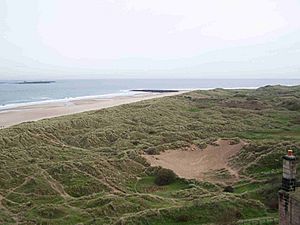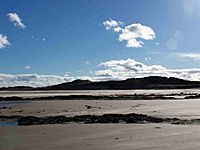Bamburgh Dunes facts for kids
| Site of Special Scientific Interest | |

The southern area of Bamburgh Dunes seen from Bamburgh Castle
|
|
| Area of Search | Northumberland |
|---|---|
| Coordinates | 55°36′29″N 1°42′11″W / 55.608°N 1.703°W |
| Area | 44.64 hectares (110 acres) |
| Notification | 28 February 1995 |
The Bamburgh Dunes are a special area of sand dunes located near the village of Bamburgh in Northumberland, England. These dunes cover more than 40 hectares (about 100 acres). They sit right next to the impressive Bamburgh Castle.
Since 1995, the Bamburgh Dunes have been recognized as a Site of Special Scientific Interest (SSSI). This means they are protected because of their unique nature. They are also part of the North Northumberland Dunes Special Area of Conservation (SAC). This area is important for its many different plants and animals. You can even find "climbing dunes" here, which are formed when sand blows onto higher ground near the beach.
Contents
Exploring Bamburgh Dunes
The Bamburgh Dunes offer a mix of landscapes. You'll find open sandy beaches that lead into low ridges covered by tough marram grass. Further inland, the dunes become more stable and are covered in other grasses.
What Makes the Dunes Special?
The dunes are made up of bumpy sand ridges and hollows. These hollows can fill with water during certain times of the year. This creates different habitats for plants and animals.
Amazing Plants
Many interesting plants grow here. Some examples include the pyramidal orchid and Centaurium. You might also spot sea sandwort and petalwort. Petalwort is a very rare plant that is on the list of endangered species in the British Isles.
Incredible Insects
The dunes are home to over 500 types of insects! Some of these are very rare. For example, there's a special plant hopper called Dicranotropis divergens. There's also a grass-mining fly named Opomyza punctata and a shore fly called Psilopa marginella.
Birds of the Dunes
Many birds love to visit the Bamburgh Dunes. You might hear the grasshopper warbler or the sedge warbler. Other birds include the European stonechat, meadow pipit, and reed bunting. In winter, you might even see a short-eared owl or a water rail.
Protecting the Dunes
Over time, some strong plant species and bushes started to grow too much in the dunes. This made the sand dunes too stable. Sand dunes need to be a bit unstable and shifting for many rare plants to grow well. This was threatening the unique nature of Bamburgh Dunes.
A Plan to Help
To fix this, several groups worked together. These included the Bamburgh Castle Estate, English Nature, DEFRA, Northumberland County Council, and Bamburgh Parish Council. They created a plan to manage the dunes.
Cows to the Rescue!
Since the year 2000, cattle have been allowed to graze in the dunes. The cows help by eating the dominant grasses. This breaks up the thick grass cover and helps the sand dunes become more shifting again. A fence keeps the cattle within the dune area. People are still welcome to visit the dunes, with special stiles and gates on the main paths.
Ancient Discoveries
In 1998, archaeologists made an exciting discovery in the dunes. They found an ancient Anglo-Saxon burial ground from the 7th century. This was found south-east of Bamburgh Castle during a dig by the Bamburgh Research Project.
The Bowl Hole Burial Ground
This burial ground is called the Bowl Hole. People first knew about it in 1816. Back then, strong storms blew away a lot of sand and uncovered the site for a short time. The BBC television show “Meet the Ancestors” became involved with the dig. They even showed a program about the amazing finds in February 2001.


